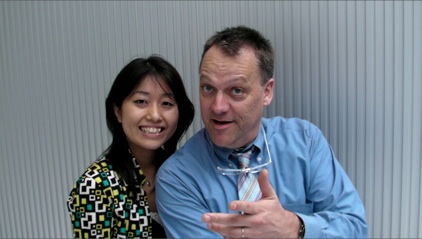日米会話学院がお届けするスクリプト付きのポッドキャストです。日常からビジネスまで幅広く役に立つ表現を学習できます。
2008.06.27
064_Indirect_Questions

Kevin discusses indirect questions with Nichibei student Hiroko.
- Kevin:
- Hello everyone. Welcome back to Nichibei Kaiwa Gakuin Podcasting. A quick and easy way to review English words and phrases. I'm your host, Kevin Jones and today today I'm speaking with Nichibei student Hiroko about indirect questions in English. So Hiroko are you ready?
- Hiroko:
- Sure, but first let me check about the meaning of indirect question.
- Kevin:
- OK. An indirect question is a question which tries to avoid a direct mention of the question.
- Hiroko:
- I'm not sure I understand.
- Kevin:
- Well then, let me give you an example of a direct question.
Where is Nichibei?
and now an indirect question.
Could you tell me where Nichibei is?
Hiroko, are these two questions the same? - Hiroko:
- Well they are asking for the same information but they don't sound the same.
- Kevin:
- They don't sound the same?
- Hiroko:
- No. The indirect question sounds more polite.
- Kevin:
- That's right. THe indirect question sounds more polite because it doesn't directly ask the question, it starts with a phrase such as
Could you tell me...
Do you have any idea...
Do you know...
Would you mind telling me...
Or other phrases which ask some if they have or know the information. - Hiroko:
- Do you know where Nichibei is?
- Kevin:
- Very good. That's a polite sounding indirect question.
- Hiroko:
- Are there any rules for making indirect questions?
- Kevin:
- Yes there are.
First, lets talk about word order. The word order in an indirect question is the same as an affirmative statement such as He is doing his homework.
The indirect question would be...
Do you know what he is doing?
Or think about the work order this way.
To make the indirect question, switch around the subject and first verb is he to he is
So What is he doing? changes to
Do you know what he is doing?.
So to check that again. We make an indirect question by starting with a polite phrase such as Do you know with the statement order of a statement such as he is.
Do you know where he is?
OK Hiroko, you give it a try. Please change these direct questions to indirect questions. - Hiroko:
- OK
- Kevin:
- What time is it?
- Hiroko:
- Could you tell me what time it is?
- Kevin:
- Right. Next. Where are the teachers?
- Hiroko:
- Do you know where the teachers are?
- Kevin:
- Good Hiroko. Next. How much is a ticket?
- Hiroko:
- Could you tell me how much a ticket is?
- Kevin:
- Good job Hiroko.
- Hiroko:
- What's the next rule Kevin?
- Kevin:
- Right. The next rule is if the direct question has do, does or did, we omit, we take it out in the indirect question. OK? So Hiroko, please change this to an indirect question.
What do you want? - Hiroko:
- Can you tell me what do you want.
- Kevin:
- Ah you forgot to remove the do. Try it again.
What do you want? - Hiroko:
- Can you tell me what you want?
- Kevin:
- Right! Next. When did she start?
- Hiroko:
- Do you know when she start...started?
- Kevin:
- That's right. We change the verb to past tense.
- Hiroko:
- Are there any other rules?
- Kevin:
- I'll give you one more. If it is a yes / no question, we use if or whether in the indirect question.
So Hiroko, try to change this to an indirect question.
Have you seen Mr. Evanish - Hiroko:
- Could you tell me if you've seen Mr. Evanish
- Kevin:
- Very good. let's try one more.
Is Mr. Trinkle coming to the party? - Hiroko:
- Do you know whether Mr. Trinkle is coming to the party?
- Kevin:
- Right!, That's it for this episode. Thank you very much for your help Hiroko.
- Hiroko:
- Your welcome Kevin.
- Kevin:
- And thank you for listening to our podcast. Next episode we'll talk about more casual ways to use indirect questions. When you have a moment why don't you visit the podcast website where you can read the transcript for this episode. The address is, www.nichibei.ac.jp/podcasting. This podcast is a production of Nichibei Kaiwa Gakuin and Live Mix Media.
END
CONTACT
 03-3359-9621
03-3359-9621
平日 受付時間 10:00-19:30
土曜 受付時間 9:45-17:30
日曜・祝日の受付は行っておりません。
 四ツ谷駅徒歩3分
四ツ谷駅徒歩3分
〒160-0004 東京都新宿区四谷1-6-2
コモレ四谷 グローバルスタディスクエア 3F
最寄り駅:四ツ谷駅 JR中央線・総武線/東京メトロ丸ノ内線・南北線
お問い合わせフォーム
メール送信が完了しました。


